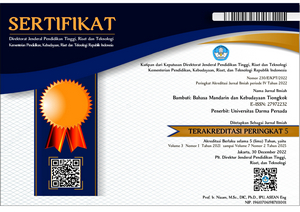The Modal Particles in the Storybook 原我这么棒 Yuánlái Wύ Zhème Bàng By Li Huizhen Partikel Modalitas dalam Buku Cerita 原来我这么棒 Yuánlái Wǒ Zhème Bàng Karya Li Huizhen
Abstract
Particles in Mandarin can be divided into three kinds, namely structural, aspectual, and modality or modal particles. The particles have their own functions, as well as having grammatical meanings. This article discusses the particles of modality in the children's storybook entitled原我这么棒(Yuánlái Wύ Zhème Bàng) 'I'm So Great' by Li Huizhen. Particles of modality are widely used in the context of the conversation in the storybook, namely 啊 a, 吧 ba, 啦la, 了le, 啰luo, 吗ma, 嘛ma, 哪na, 呢ne, 呀ya, 哟yo. Through distributional analysis methods, as well as with the technique of evaporation and transfer analysis, the modality particles can be matched with phatic particles in Indonesian, such as 'ya', 'lah', 'sih', 'lho', and 'dong' which are generally located behind sentences, and some behind clauses. However, the meaning of the particles is uncertain and unsteady because each depends on the context of the sentence or the meaning of the sentence. The presence of modality particles in a sentence can change the meaning of a sentence, its type of sentence, or its language function.

This work is licensed under a Lisensi Creative Commons Atribusi 4.0 Internasional.
Authors who publish with this journal agree to the following terms:
- Authors retain copyright and grant the journal right of first publication with the work simultaneously licensed under a Lisensi Creative Commons Atribusi 4.0 Internasional that allows others to share the work with an acknowledgment of the work's authorship and initial publication in this journal.
- Authors are able to enter into separate, additional contractual arrangements for the non-exclusive distribution of the journal's published version of the work (e.g., post it to an institutional repository or publish it in a book), with an acknowledgment of its initial publication in this journal.
- Authors are permitted and encouraged to post their work online (e.g., in institutional repositories or on their website) prior to and during the submission process, as it can lead to productive exchanges, as well as earlier and greater citation of published work (See The Effect of Open Access).









